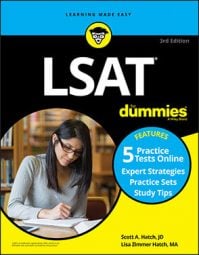The LSAT has a reading comprehension section that expects you to be able to answer questions based on the readings from different passages. Take a look at these questions to get an idea of what you might see on test day.
The questions in this article refer to the following two passages. The first is adapted from Posttraumatic Stress Disorder: Issues and Controversies, edited by Gerald M. Rosen (Wiley). The second is adapted from Post-traumatic Stress Disorder, edited by Dan J. Stein, Matthew J. Friedman, and Carlos Blanco (Wiley).
Passage A
Controversy has haunted the diagnosis of post-traumatic stress disorder (PTSD) ever since its appearance in the third edition of the Diagnostic and Statistical Manual of Mental Disorders (DSM-III). At the outset, psychiatrists opposed to the inclusion of the diagnosis in the DSM-III argued that the problems of trauma-exposed people were already covered by combinations of existing diagnoses.
Ratifying PTSD would merely entail cobbling together selected symptoms in people suffering from multiple disorders (for example, phobias, depression, and personality disorders) and then attributing these familiar problems to a traumatic event.
Moreover, the very fact that the movement to include the diagnosis in the DSM-III arose from Vietnam veterans’ advocacy groups working with antiwar psychiatrists prompted concerns that PTSD was more of a political or social construct rather than a medical disease discovered in nature. Although the aforementioned two concerns have again resurfaced in contemporary debates about PTSD, additional issues have arisen as well.
For example, the concept of a traumatic stressor has broadened to such an extent that, today, the vast majority of American adults have been exposed to PTSD-qualifying events. This state of affairs is drastically different from the late 1970s and early 1980s, when the concept of trauma was confined to catastrophic events falling outside the perimeter of everyday experience.
Passage B
Of the many diagnoses in the Diagnostic and Statistical Manual of Mental Disorders (DSM-III), very few invoke an aetiology in their diagnostic criteria: (i) organic mental disorders (caused, for example, by a neurological abnormality); (ii) substance-use disorders (caused, for example, by psychoactive chemical agents); (iii) post-traumatic stress disorder (PTSD); (iv) acute stress disorder (ASD); and (v) adjustment disorders (ADs).
The latter three are all caused by exposure to a stressful environmental event that exceeds the coping capacity of the affected individual. The presumed causal relationship between the stressor and PTSD, ASD, and AD is complicated and controversial. Controversy notwithstanding, acceptance of this causal relationship has equipped practitioners and scientists with a conceptual tool that has profoundly influenced clinical practice over the past 30 years.
PTSD is primarily a disorder of reactivity rather than of an altered baseline state, as in major depressive disorder or general anxiety disorder. Its psychopathology is characteristically expressed during interactions with the interpersonal or physical environment. People with PTSD are consumed by concerns about personal safety.
They persistently scan the environment for threatening stimuli. When in doubt, they are more likely to assume that danger is present and will react accordingly. The avoidance and hyperarousal symptoms described below can be understood within this context.
The primacy of traumatic over other memories (for example, the reexperiencing symptoms) can also be understood as a pathological exaggeration of an adaptive human response to remember as much as possible about dangerous encounters in order to avoid similar threats in the future.
The author of Passage A and the author of Passage B are most likely to agree with which of the following statements regarding PTSD?
(A)Sufferers of PTSD are preoccupied with concerns about personal safety.
(B)It can be argued that the very ratification of PTSD relies more on politics than medical evidence.
(C)The diagnosis of PTSD is highly controversial.
(D)The concept of trauma is limited to catastrophic events that most won’t experience in a lifetime.
(E)Sufferers of PTSD want to remember as much as they possibly can about dangerous encounters and situations so that they can avoid similar threats in the future.
Which of the following titles would most appropriately fit both passages?
(A)PTSD: A Brief History of a Modern Controversy
(B)Falsehoods in the Diagnostic and Statistical Manual of Mental Disorders
(C)The Alarming Growth of PTSD in America
(D)PTSD: Fact or Fiction?
(E)PTSD: A Case Study
Which of the following arguments is NOT made by the author of either passage?
(A)By today’s definition of a traumatic event, most Americans have been exposed to one.
(B)PTSD sufferers are more likely than an average citizen to feel that they are in danger.
(C)Clinical practice has been heavily influenced by the presumed causal relationship between a traumatic stressor and cases of PTSD, acute stress disorder, and adjustment disorders.
(D)The decision to include PTSD in the Diagnostic and Statistical Manual was encouraged by advocacy groups working on behalf of Vietnam veterans working with antiwar psychiatrists.
(E)Sufferers of PTSD experience a lack of interest in day-to-day activities they used to find enjoyable.
Answer Key
C. The diagnosis of PTSD is highly controversial.
A. PTSD: A Brief History of a Modern Controversy
E. Sufferers of PTSD experience a lack of interest in day-to-day activities they used to find enjoyable.

